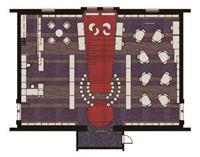Case Studies on Collaboration: Lessons Learned from the Library Initiative

The Library Initiative targets the 1.1 million students in 650 elementary schools in the country’s largest public school system. In a uniquely collaborative funding and operations partnership between the Robin Hood Foundation and the City of New York, this educational program employs architectural design and curricular integration to fight poverty by reinventing the library as a vanguard community resource. Beginning in impoverished neighborhoods experiencing some of the highest dropout rates and lowest literacy levels, school libraries have been created under a new programmatic model evolving from a multidisciplinary platform of instruction and state-of-the art facilities requirements. Each project is a provocatively designed interior renovation of approximately 1,700 square feet, the size of three common classrooms. By establishing new standards in innovation and collaboration, several architectural prototypes were tested and a new library “type” has emerged. The projects have garnered numerous design awards and extensive publicity within and beyond the worlds of architecture and design, business, philanthropy, and education. The Initiative has endowed some of the city’s poorest neighborhoods with a vital resource, tested a method for public-private partnerships and interdisciplinary collaboration, and empowered design professionals to positively impact the communities they live and work in.


Add comment
Log in to post comments